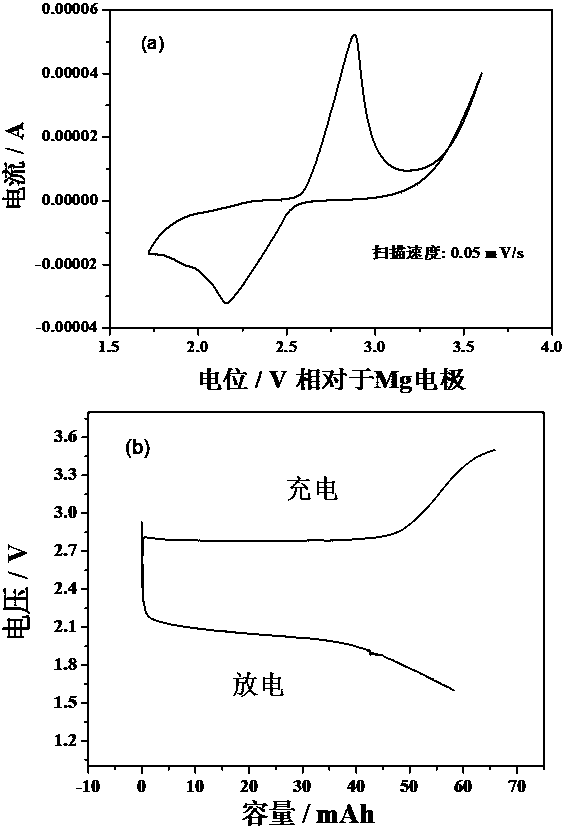High-voltage magnesium charge-discharge battery
A charge-discharge, high-voltage technology, applied in the field of electrochemistry, can solve the problems of high cathode production cost, low battery operating voltage, and low energy density.
- Summary
- Abstract
- Description
- Claims
- Application Information
AI Technical Summary
Problems solved by technology
Method used
Image
Examples
Embodiment 1
[0028] LiCoO with metallic platinum as the negative electrode current collector and a reversible capacity of 145 mAh / g 2 It is the active material of the positive electrode, wherein the weight ratio of the conductive agent, the binder, and the active material is 1:1:8. After stirring into a uniform slurry, it is coated on a stainless steel mesh to form a positive electrode piece. Take the component as 19.75Li 2 O-6.17Al 2 O 3 -37.04GeO 2 -37.04P 2 O 5 (Lithium-containing inorganic oxide) The ceramic membrane is a separator, the negative side is a mixture of THF and the grating reagent EtMgBr and LiBr, and the positive side is 1 mol / L LiNO 3 Solution. After sealing, get LiCoO 2 A magnesium charge-discharge battery with positive electrode and magnesium as negative electrode. At 0.1 mA / cm 2 The current is tested, and the charge is 0.1 mA / cm 2 Perform constant current charge, charge to 3.6V; discharge current is 0.1 mA / cm 2 , The termination voltage is 2.8 V. According to the test...
Embodiment 2
[0030] LiMn with a reversible capacity of 115 mAh / g with metallic silver as the negative electrode current collector 2 O 4 It is the active material of the positive electrode, and the ratio of the conductive agent, the binder, and the active material is the same as that of Example 1. After being stirred into a uniform slurry, it is coated on a stainless steel mesh to form a positive electrode piece. The all-solid membrane (all-solid polymer electrolyte containing lithium salt) composed of 8wt.% LiTFSI + 5wt.% Nafion 117 (product of DuPont) + 87wt.% PEO is used as the separator, and the negative electrode side is LiPF 6 , PMMA, PC, EC, Mg(SO 3 CF 3 ) 2 Polymer electrolyte, the positive side is 2 mol / l LiNO with 1 wt.% lithium polyacrylate dissolved 3 Aqueous solution. After sealing, get LiMn 2 O 4 Magnesium charge-discharge battery with positive pole and negative pole. The test conditions are the same as in Example 1. According to the test results, the average discharge voltage ...
Embodiment 3
[0032] LiFePO with a reversible capacity of 140 mAh / g with metallic copper as the negative electrode current collector 4 It is the active material of the positive electrode, and its conductive agent, binder, and solvent are the same as in Example 1. After stirring into a uniform slurry, it is coated on a stainless steel mesh to form a positive electrode piece. Take the component as 0.75Li 2 O-0.3Al 2 O 3 -0.2SiO 2 -0.4P 2 O 5 -0.1TiO 2 (Lithium-containing inorganic oxide) The ceramic membrane is a separator, the negative electrode side is a mixture of THF, Grignard reagent and LiBr, and the positive electrode side is 0.5 mol / L Li 2 SO 4 Aqueous electrolyte. After sealing, get LiFePO 4 A magnesium charge-discharge battery with positive electrode and magnesium as negative electrode. At 0.1 mA / cm 2 The current is tested, and the charge is 0.1 mA / cm 2 Charge with constant current, charge to 3.5 V; discharge current is 0.1 mA / cm 2 , The termination voltage is 1.6V. According to the...
PUM
 Login to View More
Login to View More Abstract
Description
Claims
Application Information
 Login to View More
Login to View More - R&D
- Intellectual Property
- Life Sciences
- Materials
- Tech Scout
- Unparalleled Data Quality
- Higher Quality Content
- 60% Fewer Hallucinations
Browse by: Latest US Patents, China's latest patents, Technical Efficacy Thesaurus, Application Domain, Technology Topic, Popular Technical Reports.
© 2025 PatSnap. All rights reserved.Legal|Privacy policy|Modern Slavery Act Transparency Statement|Sitemap|About US| Contact US: help@patsnap.com



